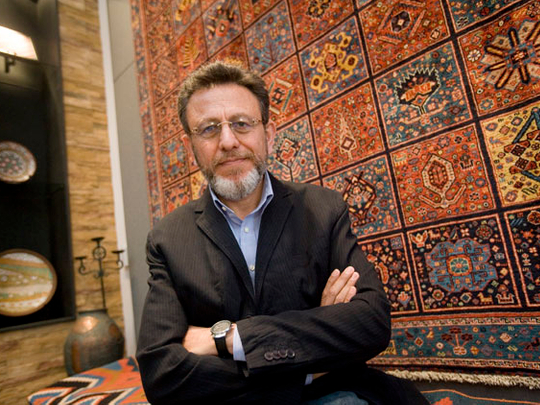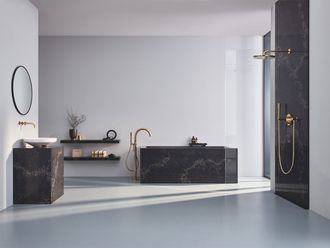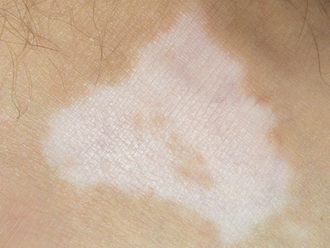
Razi Miri, MD , head designer and partner,Miri Creations, a luxury carpet shop in The Dubai Mall
I'm Iranian and I'm the fifth generation of a family to work in this field. My ancestors dealt with antique rugs from the late 18th century. They were experts in repairing damaged antique carpets. Persian carpets were cherished by people with a taste for traditional arts, people who wanted to have an original piece of art in their house which could also be used as a floor covering.
My childhood was spent watching my father collect antique carpets.
I was born in April 1951 in Tehran into a traditional Iranian family, principally engaged in the trading of antique rugs and hand-woven carpets. As a child I grew up seeing my father's love for carpets. He would often bring home spectacular rugs which he had found during his travels across the country. He would spend hours studying them and would discuss their salient features with a lot of passion. He was a true connoisseur and collector because rarely would he sell the antique carpets and rugs he found. Thus, even at a young age I grew to love these objects. After obtaining a diploma in mathematics in 1971, I joined the army but left it in 1974 to join my father at Sherkat Saderat Ghali, a company he established to deal in the sourcing and exporting of Persian rugs. SoonI became director and then managing director of the company. Since then I have dedicated my life to research in carpet weaving and design.
I am essentially an artist.
I initially had to face a lot of criticism from some of my family when I told them about my decision to enter the business. They wondered why I did not want to pursue mathematics or science (I had already secured a diploma in the former). Blame it on my genes, but my heart was set on Persian carpets and rugs. Once I made up my mind, there wasno looking back. I immersed myself into learning as much as I could about carpet weaving, dyes and yarns and was keen to live my art and explore all its nuances. I spend time developing a design. If I don't find the specific colours I want for the rug, I'll even go and make my own dyes.
The Oscar of carpet weaving goes to...
Not many people know this but there is something called the Carpet Oscar. It is awarded by an international jury of specialists to the firm that best fulfils their stringent criteria of carpet-making: originality and individuality, combined with adherence to traditional methods and designs and the use of naturally dyed handcrafted materials. And I have been the recipient of the first Carpet Oscar, a bronze sculpture awarded by the Iranian artist and tribal weaving specialist Parviz Tanavoli who was also one of the judges in 1994. I was nominated in the best contemporary hand-knotted craft art of the world section. It was awarded to me at a ceremony held at Hiibner's Kursalon in Vienna, Austria, in November 1994, when I was the managing director of Sherkat Saderat Ghali, and head designer of Miri Creations. London's Victoria and Albert Museum also recognised my achievements in carpet making by giving me an award for ‘Best Contemporary Realisations' in 1997. The next year the Carpet Museum of Iran also bestowed an honour upon me, whereby 21 examples of my creations were accepted by them. Founded in 1976, the Tehran-based museum exhibits a variety of Persian carpets from all over the country, dating from the 18th century to present times.
Rug-weaving is an art form for me.
It's something that comes straight from the heart of the weaver.
Some of these beautiful rugs can survive generations. I personally keep an eye out for antique designs everywhere - museums, books of collectors and antique markets. I study them and invest time to understand more about them. My private collection boasts quite a few of these beauties. Like music and dance, different countries have varying carpet weaving traditions. I keep this mind when I create my carpets. While I may use some modern techniques, I still adhere to the core traditional principles of Persian rug-making. Also it is impossible to replicate the design of a traditional Persian rug. However hard a weaver may try, there will always be differences in knotting and one cannot create an exact copy. Therefore every Persian carpet is a unique piece.
I bring my innovation to carpet weaving.
It was in 1985 that I started exploring the world of hand-woven carpets on a professional basis and launched Miri as my label. Two years later, thanks to a lot of painstaking research, I came up with a modern carpet design module based on ancient techniques, which were forgotten and no longer being practised in Iran. Then in 1997, I set up my own dye factory in Zarghan, near Shiraz, in Iran. It's unique in the sense that it produces only natural dyes for hand-spun wool. I even designed the machines that manufacture these natural dyes!
Photography is a passion too.
There's another passion of my life, much removed from my love for rugs and that is photography.
In fact, I still own the camera my father gave me when I was 15 - a Zeiss Ikon. In 1986, I received an award for the best ‘Nature photograph' from ‘The Annual Photographers Festival' in Tehran.
I'm doing my bit to educate the modern generation about an age-old tradition.
In the last decade, I have travelled across the world as jury, critic and adviser on carpet making and dyes to universities where carpet weaving is taught as a subject. In 1995, I attended the International Conference of Oriental Carpets in Marrakech in Morocco. I now act as adviser to the Cultural Heritage organisation of Iran. I also coach graduate students in the field of carpets. I am also deputy head of the Board of Directors of the syndicate of hand-woven carpet producers and exporters, deputy head of the Export Confederation of Iran, and a member of the Representatives Board of the Iran Chamber of Commerce, Industries and Mines.












